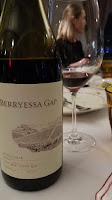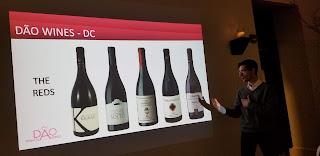After Italy, Spain is the country hardest hit by the coronavirus and like most countries, their supply of cleaning solutions and sanitizers are being depleted. To help alleviate this problem our friends at
González Byass have converted their three production facilities (Chinchón (Madrid), Jerez de la Frontera (Cádiz) and Bodega Las Copas in Tomelloso (Ciudad Real)) to manufacture and supply sanitary alcohol and hydro-alcoholic gel across Spain. Another famous producer,
Bacardi, has begun distribution of over half a million 10-ounce hand sanitizer units to local communities, focusing initially on USPS workers, firefighters, police, and its own employees and contractors (
Shanken News).
Closer to home, smaller American craft distillers are also diverting spirits production to hand sanitizers. Initially, distilleries were required to get explicit permission from both the Alcohol and Tobacco Tax and Trade Bureau (TTB) as well as the Food and Drug Administration (FDA). However, this week they both waived these restrictions as long as distillers use the recipe outlined by the World Health Organization (WHO): ethanol (80%, volume/volume) or isopropyl alcohol (75%, v/v), glycerol (1.45% v/v), hydrogen peroxide (0.125% v/v) and sterile distilled water or boiled cold water.
Here is a sample of distillers participating in this endeavor.
According to this
WKYT story,
Lexington Brewing and Distilling Co. is using their surplus alcohol supply, and chemistry knowledge to produce hand sanitizer that they are providing free to Lexington city hall. "It's been denatured so it’s not safe to drink and we surely don't want anyone to try that, its' also got hydrogen peroxide and some glycerol, a little thickening agent," said Mark Coffman, Master Distiller.
In Clarksville, Tennessee,
Old Glory Distilling Company switched from whiskey to a 96 percent ethanol hand sanitizer, and founder Matt Cunningham thanks one of their suppliers, Long Vue Farms who is supplying the corn for the distilling process. (
ClarksvilleNow.com)
In Maryland, Gov. Larry Hogan announced that "A number of our distillers from across the state are now, instead of producing alcohol, they're producing hundreds of bottles of hand sanitizer for the local communities". Scott Jendrek, owner of
Patapsco Distilling Company said they will be using a World Health Organization's recipe that "..starts with ethanol,.. then you add glycerin, hydrogen peroxide water and you mix it up," Jendrek said. (
WBalTV).
Twin Valley Distillers in Rockville and
Lyon Distilling Company are two more distilleries aiding in this effort. This
ABC3340 article also has a nice write-up of Twin Valley's founder Eduardo Zúñiga.
In Colorado,
Spirit Hound Distillers is leading the effort (
TheKnow) along with
J&L Distilling Company and
Talnua Distillery, whose co-founder and current President of the Colorado Distillers Guild says, "This is all still developing and we will see many more distilleries jumping on board with the production of hand sanitizer."
In Atlanta, Georgia
Old 4th Distillery is distributing a house-made hand sanitizer to emergency personnel (
CBS46) and
Ann Arbor Distilling Company is in on the action. According to tasting room manager Danielle Berridge, they are using the neutral spirit they use in their gin. “It’s actually made from local corn. And then we’ve got some aloe gel in there and a little bit of veggie glycerin. And then we also add water to it to bring it down to, I believe, 70%.” (
Michigan Radio).
Eight Oaks Craft Distillers (Pennsylvania) has temporarily shifted their distillation process from spirits to hand sanitizer in order to support our community, hospitals, assisted living homes, and beyond (more info
here).
Revivalist Spirits is another distillery from the Quaker state manufacturing sanitizer which owners Scott and Don Avellino are providing to healthcare professionals (
Cision).
Durham Distillery (North Carolina) will be donating their solution to
hospitality colleagues.
In Hawaii,
Ko'olau Distillery is shifting production to begin supplying hand sanitizer for critical services (
press release).
We will be updating this list as we discover more participants - in the meantime - stay healthy. Cheers.
Update (3/24/2020): There is no need to update this list as it appears most craft distilleries are transitioning to manufacturing hand sanitizer. Find your local distiller at either
WineCompass.com or
theCompass Craft Beverage Finder.
Update (4/2/2020): Apparently, the FDA and gov't regulations are hindering distillery's ability to manufacture hand sanitizer without destroying their existing equipment via
Reason Magazine.
 Please participate in these campaigns, and in addition, raise a glass to toast Juanita Swedenburg, one of driving forces behind the 2005 Granholm v. Heald Supreme Court decision forcing states to allow shipping from out-of-state wineries. "The court’s decision resolved a longstanding conflict between a state’s right to regulate the sale and use of wines and liquors, as outlined in the 21st Amendment to the Constitution, which ended Prohibition, and the Constitution’s commerce clause, which limits a state’s ability to erect economic barriers against goods shipped from beyond its borders" (NY Times).
Please participate in these campaigns, and in addition, raise a glass to toast Juanita Swedenburg, one of driving forces behind the 2005 Granholm v. Heald Supreme Court decision forcing states to allow shipping from out-of-state wineries. "The court’s decision resolved a longstanding conflict between a state’s right to regulate the sale and use of wines and liquors, as outlined in the 21st Amendment to the Constitution, which ended Prohibition, and the Constitution’s commerce clause, which limits a state’s ability to erect economic barriers against goods shipped from beyond its borders" (NY Times).















































